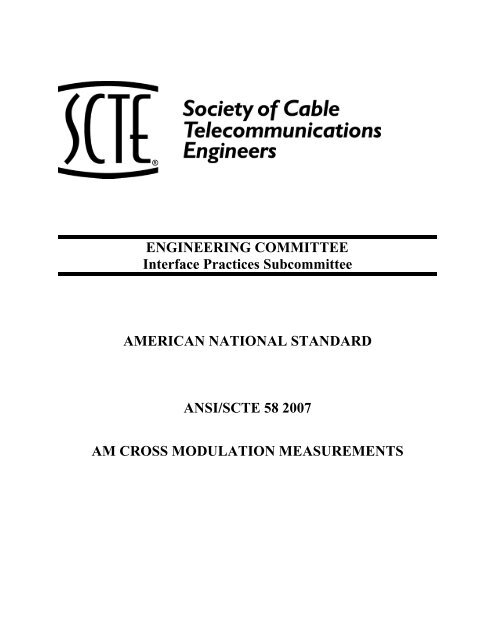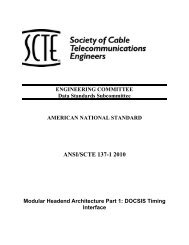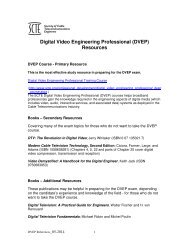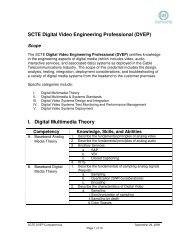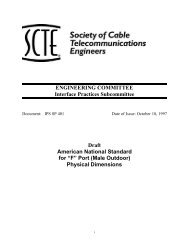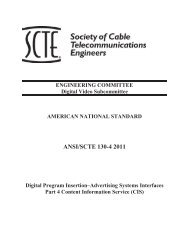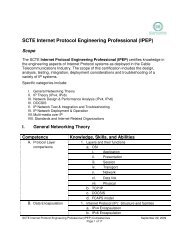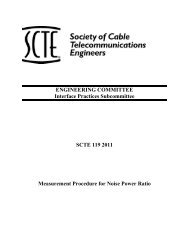SCTE IPS Template, Rev 2
SCTE IPS Template, Rev 2
SCTE IPS Template, Rev 2
- No tags were found...
You also want an ePaper? Increase the reach of your titles
YUMPU automatically turns print PDFs into web optimized ePapers that Google loves.
ENGINEERING COMMITTEEInterface Practices SubcommitteeAMERICAN NATIONAL STANDARDANSI/<strong>SCTE</strong> 58 2007AM CROSS MODULATION MEASUREMENTS
NOTICEThe Society of Cable Telecommunications Engineers (<strong>SCTE</strong>) Standards are intended to serve thepublic interest by providing specifications, test methods and procedures that promote uniformityof product, interchangeability and ultimately the long term reliability of broadbandcommunications facilities. These documents shall not, in any way, preclude any member ornonmember of the <strong>SCTE</strong> from manufacturing or selling products not conforming to suchdocuments. Nor shall the existence of such standards preclude their voluntary use by those otherthan <strong>SCTE</strong> members, whether used domestically or internationally.<strong>SCTE</strong> assumes no obligations or liability whatsoever to any party who may adopt the Standards.Such adopting party assumes all risks associated with adoption of these Standards orRecommended Practices, and accepts full responsibility for any damage and/or claims arisingfrom the adoption of such Standards or Recommended Practices.Attention is called to the possibility that implementation of this standard may require use ofsubject matter covered by patent rights. By publication of this standard, no position is taken withrespect to the existence or validity of any patent rights in connection therewith. <strong>SCTE</strong> shall notbe responsible for identifying patents for which a license may be required or for conductinginquires into the legal validity or scope of those patents that are brought to its attention.Patent holders who believe that they hold patents which are essential to the implementation ofthis standard have been requested to provide information about those patents and any relatedlicensing terms and conditions. Any such declarations, made before or after publication of thisdocument, are available on the <strong>SCTE</strong> web site at http://www.scte.org.All Rights Reserved© Society of Cable Telecommunications Engineers, Inc. 2007140 Philips RoadExton, PA 19341i
TABLE OF CONTENTS1.0 PREFACE ....................................................................................................12.0 SCOPE .........................................................................................................23.0 DEFINITIONS .............................................................................................24.0 EQUIPMENT ..............................................................................................45.0 SET-UP ........................................................................................................66.0 PROCEDURE ..............................................................................................77.0 APPENDIX A: A DERIVATION OF CROSS MODULATION. ............108.0 APPENDIX B: THEORY OF MEASUREMENT OF AM-XMOD .........239.0 REFERENCES ..........................................................................................34ii
1.0 PREFACEThis document describes a test procedure for the laboratory and production measurementof Amplitude Modulation Cross Modulation (or AM-XMOD) that is present inBroadband Systems which carry Frequency Division Multiplexed (FDM), amplitudemodulated, analog video channels. In general there are two components to the crossmodulation generated in such systems; namely, cross modulation of the direct AmplitudeModulation (AM-XMOD) type and cross modulation of the less obvious PhaseModulation (PM-XMOD) type. In the past, the PM-XMOD component was not directlyconsidered, for many pertinent reasons. With the advent of larger cabletelecommunications systems (e.g. more video channels with carrier placement at higherfrequencies), and the implementation of different equipment and technology (such asfiber optics in the distribution path), it has become necessary that the PM-XMOD at leastbe described. The physical processes by which the two components of cross modulationare generated have some fundamental differences. However, the resultant videoimpairment to the viewer can be the same if the proper conditions exist. (That is, both ofthese components have been shown to cause similar visual disturbances in the desiredpicture when the proper conditions exist and hence are considered to be trueimpairments.) The issue of how each component of cross modulation is detected atthe subscriber’s terminal (i.e. “set-top receiver”) and the subsequent perceptibilitylevels that should be specified will NOT be addressed in this document.The procedure described in this document for measuring the ‘AM-XMOD DistortionRatio’ uses an RF Receiver, to detect the modulation, and a Baseband Analyzer, tomeasure the detected modulation signal levels. The test method, as given, is meant tomitigate the effects that PM-XMOD has upon the accurate detection of AM-XMOD. Acommon alternative to this measurement technique is to measure the AM-XMOD using aspecific instrument, namely the ‘Spectrum Analyzer’. The Spectrum Analyzer has thecapability to both detect and measure the magnitude of the modulation level (i.e. thelevels of the sidebands) in the frequency domain. An AM-XMOD measurement that usesthis "frequency domain" technique will be different from a measurement made using thetechnique described in this procedure, because the Spectrum Analyzer can notdiscriminate AM and PM sidebands. The type of detector used in the RF Receiver, aswell as the method of detection used in the Baseband Analyzer to measure the sidebandenergy of the modulation, will be specified.The detectors used in the RF Receiver and the Baseband Analyzer instruments aredifferent than those used in a typical Spectrum Analyzer. Therefore, a SpectrumAnalyzer, where used in this document, is understood to be a separate instrument fromeither an RF Receiver or a Baseband Analyzer. However, it is generally understood thata Spectrum Analyzer can be used as a receiver instrument, whereby either the IF output istaken and RF demodulation is accomplished externally by a separate detector, or theSpectrum Analyzer’s (Linear) demodulator is used. In either approach, afterdemodulation, a Baseband Analyzer then detects the video modulation.1
2.0 SCOPE2.1 This document describes a test procedure for the laboratory and productionmeasurement of Amplitude Modulation Cross Modulation (or AM-XMOD) that ispresent in Broadband Systems which carry Frequency Division Multiplexed(FDM), amplitude modulated, analog video channels.2.2 A measurement procedure for AM-XMOD will be given.2.3 The measurement procedure for PM-XMOD will NOT be given.2.4 A more in-depth theoretical discussion of cross modulation, including adescription of the physical generation and manifestations, is given in Appendix A.An outline of a derivation for an expression of PM-XMOD is given therein.2.5 The baseband detection of the AM-XMOD component, and the differencesbetween detection methods, is handled in Appendix B.2.6 The PM-XMOD component’s effect on the measurement of AM-XMOD,including the resulting errors in measurements of the magnitude of the detectedamplitude modulation, is explained in Appendix B.3.0 DEFINITIONS3.1 Amplitude Modulation (AM) is defined as “a low frequency (i.e. baseband)signal, which is multiplied with a high frequency (i.e. carrier) sinusoidal signal, inorder to modulate the peak amplitude levels of the carrier signal by 100% or less.For analog video Cable Telecommunications systems, the modulationcharacteristic is described as ‘downward only modulation’.” The signal has theform:F AM (t)= V pk μ m(t) cos (w c t +θ)Where:V pk ≡ The peak amplitude of the carrier signal.μ ≡ The index of (amplitude) modulation: 0 ≤ μ ≤ 1m(t) ≡ The baseband signal whose highest frequencycomponent is w m (w m
3.2 Cross Modulation can be broadly defined as “a distortion, resulting from the nonlinearityof a system, which causes a carrier in the system to be modulated by thevarious desired signals carried on the other channels in the same system.” Thisgeneral definition will cover both components of Cross Modulation distortion,AM-XMOD and PM-XMOD.3.3 The “Amplitude Modulation Component” of the cross modulation, or AM-XMOD, was traditionally defined in the same manner as the definition of crossmodulation given above in Section 3.2. However, in this document, an additionalclarification is made. “AM-XMOD is specifically defined as the ratio of the peakto peak amplitude modulation on the test carrier, caused by the modulatingsignals on the other carrier signals in the system, to the peak to peak amplitudemodulation on a 100% modulated test carrier. It is a measure of the relativemagnitude of the voltage of the undesired modulation, to that of the desiredmodulation, at the fundamental frequency of the modulating signal.”3.4 The conditions for the test define the modulation type, as follows:All test carriers are to be 100%, downward only, amplitude modulated by asynchronous square-wave signal (i.e. the same baseband signal synchronouslymodulates all carriers in the system), possessing a modulating frequency equal tothe desired video format’s horizontal sync pulse, with a duty cycle of 50%. Forthe NTSC video signal format, this frequency is approximately 15.75 kHz. (Note:this will be the frequency of modulation used throughout this procedure.)However, for testing of fiber optic equipment, approximately 5% of the carriersignals may remain unmodulated in order to provide a minimum signal levelwithin the active fiber optic components. The number, channel and frequencylocation of these unmodulated signals shall be included as part of the test data.3.5 “Downward modulation” is understood to be amplitude modulation of a carrierfrom a reference carrier amplitude level such that the reference carrier amplitudelevel is never exceeded. (In fact, this is what is intended in the definition insection 3.1 above, as “1 ≥ m(t) ≥ 0”.)3.6 Refer to the Glossary and Definitions section of ANSI/<strong>SCTE</strong> 96 2007 for otherdefinitions.3
4.0 EQUIPMENT4.1 The general equipment required for this test is shown in Figure 1a or 1b.ANSI/<strong>SCTE</strong> 96 2007 describes and specifies all of this equipment.4.2 The multi-tone signal generator for this test must have the characteristics listedbelow. Refer to ANSI/<strong>SCTE</strong> 96 2007for specifications of acceptable generators.4.2.1 The capability to produce signals on all nominal visual carrier frequenciesfor all of the channels in the frequency band to be tested.4.2.2 The capability to set power levels individually and to adjust the totalspectrum of input signals to the proper input power level for the device tobe tested.4.2.3 The capability of synchronously downward amplitude modulating allchannels 100%, at a modulating frequency equal to the desired videoformat’s horizontal sync pulse, with a duty cycle of 50%. (Note, for anNTSC video signal, this frequency is approximately 15.75 kHz.)4.2.4 The capability to turn the modulation off for individual channels.4.2.5 Spurious signals generated from within the signal source itself must be atleast 10 dB below the distortion levels, to be measured. Note that, if theinternal AM Cross Modulation generated by the signal source is producedin a manner similar to that produced by the “Device Under Test” (orDUT), then the levels of those distortion products must be at least 20 dBbelow the levels produced by the DUT to insure measurement certainty.4.3 An RF Receiver is required for this measurement. Several different instrumentsmay be used, but regardless of the specific form of the instrument the RFReceiver must have the characteristics listed below. Note: Most SpectrumAnalyzers, with the appropriate Resolution Bandwidth Filter setting, can be usedfor this application. Refer to ANSI/<strong>SCTE</strong> 96 2007for specifications of acceptableRF Receivers.4.3.1 The capability of tuning to the (video) carrier frequency of measurement.4.3.2 The capability of rejecting energy from image frequencies associated withthe (internal) down-converting active devices of the instrument.4
4.3.3 The capability of providing a “bandwidth selectable” Band Pass IF Filter(i.e. a ‘Resolution Bandwidth’ filter) at the input to the receiver’s RFdetector. The filter is to provide selectivity to the modulated video carrierof interest and it must therefore provide adequate rejection of adjacentcarrier signal energy. However, the filter must also have a bandwidthlarge enough to pass the modulation signal under test, so that theamplitude modulation sideband energy is properly passed through to thedetector. (Namely, no significant energy of the AM sideband is to berejected, and the conversion of phase modulation energy to AM energy,due to slope detection, is to be prevented.) Typically this is a RBW = 1MHz.4.3.4 The capability of detecting modulation via “Linear Amplitude”, or “LinearEnvelope” detection, for the measurement of AM-XMOD. (Specifically,the detector chosen must be capable of providing an output voltage that isdirectly proportional to the magnitude of the envelope of the carriersignal.) Alternatively, a “Square Law”, or “True RMS” detector can beused. Note however, that a correction factor must then be applied, inaccordance with the resulting difference in magnitude between themethods. This is a linear factor of “2”, which would result in anadditional 6 dB level, assuming the units of display utilized by theBaseband Analyzer are given in ‘20*LOG(measured voltage)’.4.3.5 The capability of providing an output voltage for the baseband signal, thatis directly proportional to the magnitude of the detected signal.4.4 A "Baseband Analyzer" is also required for this measurement. Several differentinstruments may be used, but regardless of the specific form of the instrument, theBaseband Analyzer must have the characteristics listed below. Refer toANSI/<strong>SCTE</strong> 96 2007 for specifications of acceptable Baseband Analyzers.4.4.1 The capability to measure the signal level at a frequency of the modulation(which for NTSC video is 15.75 kHz).4.4.2 The capability of providing a peak voltage measurement, for themeasurement of AM-XMOD.4.4.3 The capability of providing a “Resolution Bandwidth” Filter, either at theinput to the detector or incorporated into the method of detection, in orderto provide a measurement dynamic range at least 10 dB better than theAM-XMOD distortion levels to be measured. The Resolution Bandwidthmust be operated with a BW ≤ 100 Hz. [Note: Narrower resolutionbandwidths can be used and allow better measurement repeatability, but atthe expense of longer measurement time.]5
4.4.4 The use of a separate RF Spectrum Analyzer for this application may beunsatisfactory, even if it is specified to operate at the desired frequency of15 kHz. Typical low frequency Baseband (Spectrum) Analyzers using‘Fast Fourier Transform’ signal processing have a noise level at least 50dB lower than most RF Spectrum Analyzers.4.5 The band pass filters (BPF) for this test must meet the specifications listed inANSI/<strong>SCTE</strong> 96 2007.5.0 SET-UP5.1 Follow all calibration requirements recommended by the manufacturers ofthe Signal Generator, RF Receiver and Baseband Analyzer equipment,including adequate warm-up and stabilization time.5.2 Connect the test equipment as shown in Figures 1a and 1b.RF SignalSource(Analog;CW)*HPFFixedATTTer m.DUT6 dBATTBPF*SwitchedATT* PreAmpR FReceiverRF SignalSource(Digital;Modulated)*OptionalComponentsFixedATT*LPFRF SignalSource(<strong>Rev</strong>erse; CW,Digital or Hybrid)BasebandAnalyzerFigure 1a6
Or,RF SignalSource(Analog;CW)*HPFFixedATTTer m.DUT6 dBATTBPF*SwitchedATT*PostAmp6 dBATTSpectrumAnalyzerRF SignalSource(Digital;Modulated)*OptionalComponentsFixedATT*LPFRF SignalSource(<strong>Rev</strong>erse; CW,Digital or Hybrid)BasebandAnalyzer*BBAmpFigure 1b5.3 If appropriate, power the Device Under Test (DUT) in a manner consistent withits use. Note that the DUT may consist of a single device or a group of devicesconnected together as a system.5.4 Connect the video output of the RF Receiver to the input of the BasebandAnalyzer.5.5 Set the signal generator(s) to provide all of the signals needed for the test, asdefined by the applicable frequency plan.5.6 Set the appropriate signal level for each carrier, using the techniques described inANSI/<strong>SCTE</strong> 96 2007.6.0 PROCEDURE6.1 Adjust and/or tune the BPF so that its pass-band response is centered onthe carrier to be measured.7
6.2 Set the RF Receiver to the settings indicated in Table 1, below. Note: Ifan RF Spectrum Analyzer is used as a tuned receiver, then the Spanshould be set to ZERO Hertz, the vertical scale should be set to LINEARand the Reference Level adjusted until the display is near full scale.Center FrequencyDetectorResolution BandwidthVideo Bandwidth (if applicable)Input AttenuationSweep TimeCarrier Frequency under testLINEAR (or RMS)1 MHz≥ 1 MHz≥ 10 dB*Auto**Vertical ScaleLinear***Table 1* The RF Receiver input attenuation may be manually set to 0 dB to improve the dynamicrange of the measurement, but only when one can be certain that the equipment will notbe overdriven.** The “Sweep Time” used should depend upon the instrument’s limits of calibratedoperation, as well as the minimum acceptable measurement speed desired by the user.*** See comments in paragraph 6.2 above.6.3 Turn the synchronous 15.75 kHz square-wave, 100% downward AMmodulation ON for all channels.6.4 Tune the Baseband Analyzer to the modulating frequency, 15.75 kHz.Ensure that the signal displayed on the Baseband Analyzer is at the fullscale of the display. Ensure that the Resolution Bandwidth of theBaseband Analyzer is ≤ 100 Hz. (Note that a narrower basebandmeasurement bandwidth will produce a lower measurement noise floorand thus a more stable, more repeatable measurement.)6.5 Record the peak level of the 15.75 kHz signal measured on the BasebandAnalyzer as Reference Sideband Level.8
6.6 Turn the modulation OFF for the carrier under test.6.7 Record the level of the 15.75 kHz signal measured by the BasebandAnalyzer as the RAW AM-XMOD Level.6.8 Tune the Baseband Analyzer slightly off the 15.75 kHz signal, to a flatportion of the spectrum, within the RF Receiver’s video bandwidth.6.9 Record the level measured by the Baseband Analyzer as Noise FloorLevel. Compute the following:Noise Floor Delta = RAW AM-XMOD Level – Noise Floor Level.If the Noise Floor Delta is less than 2 dB, the bandwidth of the BasebandAnalyzer can be reduced, or an appropriate post-amplifier can be added tothe system. The measurement should then be made again. If, however,the Noise Floor Delta remains less than 2 dB, refer to ANSI/<strong>SCTE</strong> 962007 for the proper Noise Floor Correction Factor.6.10 If the Noise Floor Delta is greater than 2 dB, the following Noise FloorCorrection Factor should be calculated:Noise Floor Correction Factor:10 *⎛log⎜1-10⎜⎝⎛ Noise Floor Delta ⎞−⎜⎟⎝ 10 ⎠A table of values calculated from this equation is presented in ANSI/<strong>SCTE</strong> 962007.6.11 Compute the “corrected AM Cross Modulation” as:Corrected AM Cross Modulation, referenced to sideband =Reference Sideband Level – RAW AM-XMOD Level + Noise FloorCorrection Factor + (6 dB, if using an RMS detector)Note that this is a positive number, expressed in ‘-dB’ (i.e. negative dB),in accordance with the definition given in section 3.3. (If necessary, referto the Glossary and Definitions section of ANSI/<strong>SCTE</strong> 96 2007 for adiscussion of these units.)⎞⎟⎟⎠9
7.0 APPENDIX A: A DERIVATION OF CROSS MODULATION.In this appendix the derivations of the classical AM-XMOD expression and an expanded crossmodulation expression, that embodies both an AM-XMOD and a PM-XMOD component, willbe outlined separately. A thorough discussion of the consequences of each of the expressionsobtained in the analysis will be presented. Most importantly, the consequences in the practicalmeasurement of the AM-XMOD level will be detailed for each case.As is well known, active devices used as building blocks for amplifiers are composed ofsemiconductor junctions. These junctions control the transport of charge (i.e. current) throughthe device and provide the fundamental mechanism for power gain. The nonlinear(mathematical) models for these junctions and their effects on the signals being amplified areoften derived for two important cases: the ‘static’ case and the ‘dynamic’ case. It is these twocases that give rise to the two components of cross modulation.Specifically, a simplified expression for the AM-XMOD is derived from consideration of thestatic case. Consideration of the dynamic case results in a more complex derivation of crossmodulation, which gives rise to a more complex expression for AM-XMOD. Therefore, thereare differences in the expression for the AM-XMOD in the dynamic case, from the static case.This difference conveys possible measurable effects in the level of the AM-XMOD componentand can determine the ultimate repeatability of the measurement.The more complex derivation of the general expression for cross modulation, from considerationof the dynamic case, leads to the added result that an additional component manifests itself in theform of Phase Modulation, upon the carrier signal, even though that particular’s carrier isunmodulated. Although this effect is on the carrier phase, the form is similar to the (morecomplex) expression for the AM-XMOD component and results in additional spectral sidebandenergy. This additional energy leads to consequences that can change the measured level of theAM-XMOD component, under certain conditions. Simply stated, “the existence of PM-XMODcan lead to a change in the measured level of the AM-XMOD.” This important theoretical resultwill also be presented in this appendix.The treatment of the two cases (i.e. the ‘static’ and the ‘dynamic’) and the perceived effects, arebased upon different assumptions about how the device behaves physically. It is theseassumptions that are important in determining which case is pertinent in the practical applicationof the measurement.10
AM-XMOD: Derivation of Cross Modulation from the Static Case:If we consider a device operating in the region where its junction characteristics are based uponthe ‘classic diode equation’ (e.g. a semiconductor junction whose voltage and currentrelationship is exponential), then modeling of the nonlinear characteristics of the device can besimplified. The nonlinear current-voltage relationship can be modeled by a polynomial function,simply by using the mathematical series expansion for the exponential function. In summary, ifthe signal source voltage across the junction is “not too large”, the gain compression and thegeneration of distortion of the device can then be modeled by a simple polynomial expression.Specifically, the output of the device is a polynomial expansion of the power gain curve (aboutits DC operating point) and has the input signal as the independent variable. In mathematicalform this is expressed as:y(t) = k 1 x(t) + k 2 [x(t)] 2 + k 3 [x(t)] 3 + … + k i [x(t)] i{A.1}where,x(t) ≡ The time dependent input waveform.y(t) ≡ The time dependent output waveform.k i≡ Real constants, representing the ‘gain coefficients’.This expression has an important assumption associated with it. The assumption is that‘although the output waveform is not linearly dependent on the input waveform, the outputwaveform is dependent only upon the value of the input waveform at the particular pointin time under consideration’. The output waveform therefore, does not depend on past valuesof the input waveform. In this sense the system is “static”; or, in a more mathematically correctterm, it is ‘memory-less’. Consequently, a delay in the input waveform will result in acorresponding delay in the output waveform. As a result, the phase relationship between theinput and output waveforms is constant - even though the output waveform is a distortedrepresentation of the input. (This system is deterministic and causal.) The consequence of theabove assumption is that the junction capacitance is completely ignored. Therefore thetime dependent voltage and current relationships of the junction capacitance are notincluded in this physical model.In order to derive an expression for AM-XMOD a few other assumptions are made.11
First, we expect the device to exhibit a ‘weakly non-linear’ characteristic, meaning that the inputsignal levels are small enough as to not cause a measurably large change in the average levels ofthe voltages and currents of the device. (This is what was previously meant by, “the signalsource voltage(s) across the junction are ‘not too large’.”) In this case, only the first three (3)terms of the expansion are considered significant, thus simplifying our final expression for crossmodulation. The only terms considered then, are those associated with the linear gain (i.e. k 1 )and those associated with the slopes of the second and third order transfer characteristics (i.e. k 2and k 3 , respectively). Note that these terms do not contain any time dependencies.Therefore, they do not impart any phase dependencies onto the result.Second, we consider the input signal as comprised of a finite sum of equal amplitude sinusoids(i.e. we will consider a system that is of the Frequency Division Multiplexed (FDM) type, astypically found in analog cable telecommunications systems). This is expressed as:x(t) = Σ n A n cos(w C n t + θ C n ){A.2}where,w C n ≡ the individual radian frequencies of the channel carriers.θ C n ≡ the individual phases of the channel carriers (not necessarily equal).Third, we assume that all channels have the same (peak) amplitudes. Also, that if AMmodulation is present, it is the same on all channels. Therefore, A n are given by an amplitudemodulation expression, A(t), similar to the one presented in section 3.1.The derivation and parts of the following example are readily found in the literature and will notbe presented in full detail here, but the results will be used.12
We apply the assumptions given and mathematically expand (algebraically andtrigonometrically) the output waveform in terms of the input waveform. Upon collecting termswe find that we have two specific categories of distortions in addition to the linear gain of theinput waveform and a shift in the DC bias level of the device. The two categories of distortionsare 1) those terms associated with the generation of ‘new frequencies’ and 2) those termsassociated with Gain Compression. The terms associated with the generation of ‘newfrequencies’ are made up of the second and third order harmonic frequencies and the second andthird order inter-modulation (IMDs) frequencies, including the third order products commonlyknown as “Triple Beat Distortion”. Those terms associated with Gain Compression are ‘thirdorder’ in nature; that is, the magnitudes of these terms are proportional to the slope of the thirdorder transfer characteristic k 3 . ¥ It must be noted that compression refers to a decrease in thesignal level, at the channel of interest. This will only be true if the coefficient “k 3 ” is negative,as is the case for the physical systems we are considering. ‡ Therefore, “compression terms”are distortion terms that specifically affect the amplitudes of the corresponding channels,in the output waveform.Gain Compression can also be broken down further, into two more ‘sub-types’ of distortion:those associated with ‘Self-Compression’ and those associated with ‘Cross-Compression’. Thetwo sub-types do show an important difference in their terms. The magnitudes of the Self-Compression terms depend on the input amplitude level solely at the carrier frequency (i.e.channel) of interest - hence the name given to the sub-type. The magnitudes of the Cross-Compression terms depend however, not only on the input amplitude level at the channelfrequency of interest, but also on the ‘sum-of-the-squares’ of input amplitude levels of all theother channel frequencies in the system. As a result of these two facts, important characteristicsexist between the two sub-types of Gain Compression. The most obvious characteristic is aconsequence of these two sub-types being caused by the same physical occurrence. Being that,when the amplitude of the channel of interest is ‘Zero’ (i.e. when the channel of interest isturned OFF, in the system) then distortion due to the Gain Compression, whether Cross-Compression or Self-Compression, ceases to exist for that particular channel. In fact, thepart of the Cross-Compression energy (i.e. Cross-Compression distortion term) of that particularchannel, that exists at all the other channels, disappears and alleviates some of the distortion onthose channels. Another important characteristic, which is the important difference between thetwo sub-types, is that in a physical system, Self-Compression cannot be readily separated fromthe channel’s carrier amplitude level and therefore cannot be measured practically, while Cross-Compression levels can be measured in a practical way.¥ To be strictly correct, terms associated with Gain Compression are ‘odd order’ in nature - that is, the magnitudesof these terms are proportional to the slopes of the fifth, seventh (etc.) order transfer characteristics, k 5 , k 7 , etc., aswell as the third. However, for the purposes of this discussion, the higher order terms are consideredinconsequential.‡ Alternatively, it can be stated that the components of compression are always produced with a 180° (i.e. π radians)phase, in reference to the ‘original’ (or, linearly amplified) channel of interest.13
Note that, our focus is on the mathematical terms associated with “Cross-Compression”. Theseterms then give an output expression, for any particular channel of interest, which includes theAM-XMOD component.Consider a device (or system) of the type that can be described by equation {A.1} and has, as itsinput, a signal described by equation {A.2}, including amplitude modulation of the type given insection 3.1. If we include the previously stated simplifications, an output expression for aparticular channel can then be written. If we exclude all second order terms, as well as allharmonic and inter-modulation terms, the expression is:y o (t) = k 1 A 1 (t) {1 + (3/2) (k 3 / k 1 ) {(1/2) [A 1 (t)] 2 + [A 2 (t)] 2 + [A 3 (t)] 2 +[A 4 (t)] 2 +…+ [A n (t)] 2 }} cos(w c t + θ c ) {A.4}where, ‘n’ is the number of channels present in the system (n ≥ 2 is implied).Note the ‘Self-Compression’ term, given by the expression “[A 1 (t)] 2 ”. The other squared termsrepresent the individual ‘Cross-Compression’ components. An expression for the amplitude ofthe particular channel, which includes the application of all simplifying assumptions (includingthat of synchronous modulation), is then given by:y o (t) = k 1 A 1 (t) {1 + (3/2) (k 3 / k 1 ) [V pk ] 2 (n-½) [μ m(w MOD , ϕ MOD , t)] 2 } cos(w c t + θ c ){A.5}The expression given in {A.5} contains simple amplitude modulation, hence the description as“AM-XMOD”. A useful expression for the value of the AM-XMOD can then be given as (for n>> 1): † AM-XMOD% (static case) ≡ (3/2) (k 3 / k 1 ) (n) [V pk ] 2 (100) {A.6}From the above expressions, it is apparent that any channel that is amplitude modulated willtransfer some of that energy of modulation to all the other channels present in the system, aspreviously stated. It follows from this derivation that, if all channels in the system aresynchronously modulated, then the total contribution of the AM-XMOD distortion at a particularchannel should be the exact sum of the AM-XMOD distortions contributed by each individualchannel. (This is represented by the ‘(n)’ term in {A.6}.)An important consequence of the above is that, any system that doubles the number of channels,would then double the level of the AM-XMOD distortion. Equivalently, a doubling of thenumber of channels in the system increases the AM-XMOD level by 6 dB. Anotherconsequence is that, if the number of devices in a system doubles, then the AM-XMODdistortion level of the system will also double; once again, this represents a 6 dB increase in theAM-XMOD energy at any particular channel of interest. (Note: this last statement is true only ifthe input levels to each device in the system remain unchanged.)† A complete derivation is given in the references.14
If one considers the amplitude levels of the channels, then it is observed that for each 1 dBchange in amplitude level for all the channels in the system, the AM-XMOD distortion level fora particular channel will change by 3 dB and the AM-XMOD distortion ratio changes by 2 dB.Equivalently, for each doubling in level of all the channels in the system, the AM-XMODdistortion level will quadruple, for each and every channel. (Note: This is represented by the‘[V pk ] 2 ’ term in {A.6}.) This implies a fixed 2:1 relationship, in dB, of the ratio of the observedthird order distortion level and the amplitude of all the channels. In fact, a fixed relationshipdoes exist between the two types of third order distortion; namely, AM-XMOD (as described inthe above derivation) and “Triple Beat” distortion. It is an important and useful fact that indeeda relationship does exist.Finally, the only way to measure the energy of the cross-compression term at a particularchannel is to disable the modulation of that particular channel. (That is: if one is to measure theenergy of the AM-XMOD distortion at a particular channel, then one needs to turn OFF themodulation on that channel.)One last issue, which has caused much misinterpretation and debate, regards the actualamplitude reference level that should be used for the measurement of AM-XMOD. Thecontroversy resides in whether or not the AM-XMOD energy is measured referenced to theamplitude of the channel carrier when the modulation for that particular channel is OFF, or ON,or even whether the reference amplitude should actually be the 15.75 kHz sideband of thechannel carrier’s modulation. Since, for the fixed type of modulation signal as given in thisdocument there exists a fixed relationship between these quantities, one needs only to make clearexactly which reference was used in the measurement.AM-XMOD and PM-XMOD: Derivation of Cross Modulation from the Dynamic Case:As stated in the introduction and as formulated in the previous section, AM-XMOD arises fromthe static, nonlinear nature of semiconductor junction devices. In particular, an expression forAM-XMOD was derived from the exponential current-voltage relationship, which typicallyexists in a bipolar junction diode or transistor. However, practical devices exhibit dynamicphysical phenomena that change the characteristics of the non-linearity. If we consider thedynamic characteristic of the semiconductor junction, we must include the time dependentcurrent-voltage relationship of the junction capacitance(s) of the device(s). One now asks,“What is the effect of including the time-dependent nature of the junction?” The answer to thisquestion is, “that we need to add to our previous model the capacitance of the junctions, whichrepresent the physical non-linear time dependent nature of the transport of charge”.In general, the solution to the problem of the behavior of the nonlinear junction then becomesone of using advanced mathematical techniques in order to solve the resultant nonlineardifferential equation. The solution is not algebraic – the solution depends, not only on themagnitude of the source signal, but also on the time-rate-of-change of the source signal due tothe (non-linear) junction capacitance.15
A fundamental point can be ascertained from this ‘second order’ nonlinear model. That is, boththe Collector-Emitter and the Collector-Base junctions impart a time dependency onto thesolution. The importance of this phenomenon is far from academic. It is the physical reason forthe existence of PM-XMOD (i.e. AM to PM conversion). In short, the simple existence ofnonlinear junction capacitance in a semiconductor device (used to amplify any number ofamplitude modulated channels), will impart an added phase distortion to the channel signalsthemselves.In general, because the magnitude of the junction capacitance depends upon the magnitude of thevoltage across it, any time dependence in the signals being processed by the junction is thentranslated as a time dependent capacitance. Moreover, the internal structure of the deviceincludes an inherent ‘feedback capacitance’. The transfer function of the device (i.e. the input tooutput voltage relationship) no longer is a simple non-linear curve whose characteristic isindependent of time (or of frequency). This relationship must now be described by a nonlineardifferential equation whose coefficients are not simple (i.e. constant). In fact, the coefficients arenonlinear themselves, having a dependency upon the dependent variable (e.g. the output signal).In conclusion, time dependent (amplitude and phase) distortion can result.Clearly, the expression for the gain compression cannot be modeled by a polynomial functionwith constant, time independent coefficients. To solve this general problem, one can use aVolterra series expansion. The Volterra series expansion is an approximation to the generalsolution. It consists of a series of terms, which are an approximating expansion to the nonlinear(integral-differential) system equation. Each term therefore, is a convolution integral of theinput waveform and an approximating system sub-function. Each system sub-function has acomplexity that is the order of the non-linearity considered. Hence, the first expansion term inthe series (i.e. the first convolution integral) represents the solution to the linear system, whilethe third expansion term represents the solution to the third order non-linearity of the system. Insummary, the Volterra series expansion is a sum of terms, wherein each term consists of aconvolution integral that represents the system solution to a particular order of (non-) linearity.In addition, each system function (contained within the convolution integral) is an independent(i.e. orthogonal) impulse response, whose arguments contain the fundamental time constants ofthe system. An input waveform composed of many (discrete) frequencies will then causemultiple impulse responses by the non-linear system. In essence, each Volterra term’s solution(i.e. result) partly depends upon the particular set of (discrete) frequencies of the input waveformconsidered. The Volterra series allows a system, including one with ‘memory’, to be regarded asa combination of systems, wherein one is a linear system and the others are nonlinear systems oforder two and higher. In fact, the solution given by the power series of the static case shouldresemble the dynamic case, since the power series are a simplification of the more generalsolution obtained in the dynamic case, using the Volterra series.16
Using the Volterra theory, we can represent our nonlinear system as:y(t) ≡ y 1 (t) + y 2 (t) + y 3 (t) +…+ y i (t)higher order nonlinear systems {A.8.a}In general,y i (t) ≡ i th order nonlinear subsystem of the Volterra series expansion,where i > 1Concentrating on the 1 st and 3 rd orders and assuming our input is x(t), we have:y 1 (t) = ∫ h 1 (τ) x(t-τ) dτ and {A.8.b}y 3 (t) = ∫ ∫ ∫ h 3 (τ 1 , τ 2 , τ 3 ) x(t-τ 1 ) x(t-τ 2 ) x(t-τ 3 ) dτ 1 dτ 2 dτ 3{A.8.c}Since each term in the Volterra series is a convolution integral of a system function and the inputwaveform, the solution of the output response can be determined with the methods of ‘FourierAnalysis Theory’.Using the ‘Fourier Theory of Transformation’ for the system functions gives, in general:Η i (jw 1 , jw 2 , …, jw i ) = ₣{ h i (τ 1 , τ 2 , …, τ i ) }{A.9}Η i can be regarded as the transfer function of the i th order nonlinear subsystem, whose argumentsdepend upon a particular set of discrete frequencies of the input waveform, as well as the timeconstants of the system.Whether it is from measured data, or from a computational system analysis, the dependence ofthe system response at these frequencies must be known. The implication of this is not subtle;some basic knowledge of the system's response to the input excitation is mandatory. Obviously,knowledge of the input signal is ‘a priori’ for a solution.A derivation of the dynamic case, using the Volterra series, will not be given since it can befound in the literature. However, the assumptions used in the derivation will be stated and theresults will be used to define the PM-XMOD component. An expanded expression for the AM-XMOD component will be given, as well. The differences between the static case and thedynamic case for the AM-XMOD component can then be related to actual changes in the signalcharacteristics of the measured distortion.The first assumption refers to the stability of the active device(s) in the particular amplifiercircuit of interest. The use of the Volterra series requires the device to be (asymptotically)stable, so that the physical characteristics of the device do not change.17
The second assumption is that the non-linearity of the device is ‘incremental’, meaning that thedistortions are a fraction of the energy (i.e. < 40 dB) below the channel carrier amplitudes. (Thispurposely is not precise; it only illustrates the magnitude of ‘incremental’.) The output responsewill then be considered adequately described by the first three terms of the Volterra expansion(i.e. only the second and third order non-linearities, in addition to the linear response, will beconsidered).The third assumption is that the input waveform should not produce very large peak signallevels. (Again this is not precise, but is important to understand that the formulated resultdepends upon the convergence of the series expansion.) Note that this third assumption isclosely related to the second assumption, but is used for a different purpose. It will allow us toformulate a ‘closed-form’ solution without specific details of all of the system’s transferfunctions.As described previously, the higher order transfer functions of the non-linear system (withmemory) are dependent on more than one frequency component. We will greatly simplify theproblem by considering these transfer functions to be ‘single-frequency dependent’, which is ourfourth assumption. Computationally, this means that the multivariate (i.e. multi-dimensional)transfer functions described by equation {A.8} are then considered to be ‘single-variable’functions, where the variable is the sum of the input frequency components, instead of beingdependent upon each and every individual frequency component. The physical implication is,that all the distortion products being of the same type and being composed of input signals thathave the same amplitude levels, would then have the same distortion levels for the samedistortion frequency, regardless of the frequencies of the comprising (input) signals. (Or, anypair of third-order distortion products that occur at the same frequency will have the samemagnitude of distortion no matter what two, or three, different fundamental frequencies of theinput signal they are comprised from.) Note that, distortion products of the same type, located atdifferent (sum and difference) frequencies, could have different levels. The terms of equation{A.8} would then involve only one-dimensional convolutions. In addition, the non-linearsubsystems of the equation can be regarded as composed of ‘zero-memory’ networks, while thelinear term would then be ‘time-invariant’. (This would be the case if the junction capacitancewere constant.)Each term in the output response then, is a form of the input response modified by the magnitudeand phase of the particular transfer function. As in the case of frequency dependent linearsystems, the great advantage of single-frequency dependent non-linear systems is, the secondand the third order harmonic levels alone can characterize them.Typically, the linear gain of a wide-band device is flat, within the band of interest. Many widebanddevices will also exhibit transfer characteristics that have measurable third order distortionlevels that are approximately equal, when the sum of frequencies of the comprising signals isapproximately equal. This is especially true of wide-band devices whose operation is closelyapproximated by ‘unilateral’ operation, or the ‘feedback’ of the device has no appreciable (closeloop)phase. Applying these assumptions allows a formulation for the problem at hand. A18
useful expression can be derived for the cross modulation term of a time dependent non-linearsystem, when the input is a sum of amplitude modulated sinusoids.19
The fundamental output at a particular channel is given by:y fund (t) = k 1 (w c ) V pk cos(w c t + θ c – φ 1 (w c )) {A.11 }The total output of the Cross Modulation term at the channel carrier (denoted by ‘w c ’), due to thesum of the cross modulation contributions from all the other modulated channel carriers (denotedby ‘w nc ’), is given by:y xmod (t) = (3/4) [V pk ] 3 k 3 (w i ) cos(w mod t) {cos(w c t + θ c ) [Σ n cos(φ 3 (w nc ))] +where:+ sin(w c t + θ c ) [Σ n sin(φ 3 (w nc ))]} {A.12}w i ≡ w c ± w mod , the frequency of the sideband{A.13}Notice that, the added relationship of the third order phase exists as a function of frequency atthe channel carriers. Therefore the cross modulation signal is composed of two signals, each inquadrature with the other, causing the effect of amplitude and phase modulation. Thismodulation is, in effect, ordinary QAM, where the ‘in-phase’ signal (I) and the ‘quadrature’signal (Q) are combined so to give a signal which is both amplitude and phase modulated; and insuch a manner as to be able to resolve the I and Q components separately, when demodulated.Combining both components {y fund (t) and y xmod (t)} and a simplification of terms, gives anexpression for the total output at the particular carrier of interest:y c (t) = k 1 (w c ) V pk [1 + b cos(ϕ) cos(w mod t)] cos[w c t + θ c - φ 1 + b sin(ϕ) cos(w mod t)]{A.14}where:b = (3/4) [V pk ] 2 √ε [k 3 (w i ) / k 1 (w c )]ϕ = - ψ + φ 1ψ = tan -1 [Σ n sin(φ 3 (w nc )) / Σ n cos(φ 3 (w nc ))]ε = n + 2 Σ q = 1 to (n-1) Σ p = (1+q) to n cos[φ 3 (w qc ) - φ 3 (w pc )]{A.15}{A.16}{A.17}{A.18}20
The final form shows that the output at a particular carrier of interest can be expressed as:y c (t) = k 1 (w c ) V pk [1 + AM-XMOD cos(w mod t)] cos[w c t + θ c - φ 1 + PM-XMOD cos(w mod t)]where:AM-XMOD (dynamic case) ≡ b cos(ϕ){A.19}PM-XMOD ≡ b sin(ϕ) {A.20}These expressions show an example of how the phase of the third order distortion can affect themagnitude of the AM-XMOD. They also demonstrate the creation of phase modulation fromamplitude modulation, in amplifiers.Close examination of the expressions given in {A.14} through {A.18} reveal importantcharacteristics of the resultant cross modulation signal. The first characteristic regards thefrequency dependence of the AM-XMOD and PM-XMOD expressions. Note that if we considerthe system to have no frequency dependence, then:ε ⇒ (2n) 2ψ ⇒ 0ϕ ⇒ 0so that b ⇒ (3/4) [V pk ] 2 (2n) [k 3 / k 1 ]therefore,AM-XMOD (dynamic case) ⇒ AM-XMOD (static case)and PM-XMOD ⇒ 0which is the expected result.In general, any particular third order distortion product will have a given phase component, notnecessary equal to any other third order phase component, and therefore the total crossmodulation distortion will neither be completely of the AM type or of the PM type. In generalthen, the resultant cross modulation distortion will always be a compilation of the two types. Inpractice, however, the higher frequencies tend to exhibit a larger PM-XMOD component,especially at the frequencies where the bandwidth of the device starts to ‘roll-off’. Themagnitude of the PM-XMOD is obviously dependent upon both the frequency of the distortionand the magnitude of the junction capacitance.21
The first result of the dynamic case considered is that there is, in general, no fixed relationshipbetween AM-XMOD of a two-channel system and that of a multi-channel system. To bespecific, one cannot in general measure the AM-XMOD from any pair of channels and use thisresult to calculate the resultant AM-XMOD due to multiple channels. The resultant multichannelcross modulation level depends upon the relative differences of the phases of the thirdorder distortions, and therefore do not necessarily add on a ‘power basis’. Sometimes, aneffective ‘average’ is assumed and the sum is added as “15 log(x)” for practicality, but thiscauses confusion as to whether or not the products add on a ‘voltage’ basis (i.e. 20 log(x) ) or ona ‘power’ basis (i.e. 10 log(x) ).The second result is that, depending upon the phase variation (vs. frequency) of the third orderdistortion characteristic of the device (or amplifier, or system), the inclusion, or the removal of,several synchronously modulated carriers can produce either an improvement in, or adegradation of, the measured AM-XMOD. A corollary to this is, that in the dynamic caseSynchronous Modulation does not necessarily produce the worst possible measured AM-XMOD. In fact, random distribution of the phase of the modulating signal, on each carrier,could produce measurements that are worse on average. A second corollary, slightly moreobscure from the first, relates the effect of the increase in energy of the AM-XMOD component,when the magnitudes of the carrier amplitudes are increased: The effect may not be closelyrelated (in magnitude) to a similar effective increase in the number of carriers (i.e. channels)added into the system, as would be expected from the static case. This would especially be truewhen adding of channels occurs at the high frequency band of the system spectrum.The third and fourth results regard the measured (i.e. effective) magnitude of the resultant crossmodulation upon detection. The third result is that, detection of the AM-XMOD component inthe general case is not the same it is in the static case – the addition of the time dependentamplitude in the AM-XMOD component causes much more uncertainty in the magnitude of thedetected signal. Therefore, a ‘peak detected’ AM-XMOD signal would give, in general, a muchdifferent result than a ‘true square law’ (i.e. ‘true RMS’) detector.The fourth result regards the detection of vestigial sideband signals. When a vestigial sidebandfilter is used as part of the detection method, then the means for conversion of PM-XMOD toAM-XMOD exists. In essence, the effective AM-XMOD magnitude that is detected changes asa function of the PM-XMOD component present.22
8.0 APPENDIX B: THEORY OF MEASUREMENT OF AM-XMODIn this section, the basic theory of the measurement of AM-XMOD will be reviewed. First, adescription of the test signal (i.e. “the stimulus”) will be given. Second, a description of theexpected response signal will also be given. The response signal is the result of the test signalbeing passed through a nonlinear system, like the one described in Appendix A. The signal thencontains the expected response, with which we must make a measurement of distortion. Finally,a brief outline will be given of the types of measurements on the resultant distortion that can bemade and the corresponding equipment used. Important to the discussion are the differentdetectors that can be used for the measurement and their possible affects on ‘dynamic range’,‘accuracy’ and ‘repeatability’.In the past, the definition of AM-XMOD has been interpreted in different ways by the industry.Some have specified the AM-XMOD as, “the ratio of the peak of the non-modulated carriersignal to the peak of the undesired modulation”, while others specify AM-XMOD as, “the ratioof the peak of the first sideband, for a 100% modulated carrier, to the peak of the undesiredmodulation”. The difference depended mainly upon the type of instrument available to make themeasurement of the resulting distortion. As it will be shown, there is an exact relation betweenthe two results, if the stimulus is consistent. The theoretical difference between thesemeasurements is stated as: the AM-XMOD referenced to the peak of the first sideband of a100% square-wave modulated carrier signal is 10 dB worse than the AM-XMOD referenced tothe peak of the non-modulated RF carrier. For results reported according to this procedure, allAM_XMOD measurements and specifications should always be referenced to the peak ofthe first sideband of a 100% square-wave modulated carrier (i.e. all reported results forthe AM-XMOD measurement should always include this factor). The primary importancefor this is ‘consistence in reporting results’.The primary stimulus is a sinusoidal waveform, whose typical frequency is in the RF range, andwhose amplitude is varied in direct proportion to a low frequency square-wave. The frequencyof the square-wave is the rate of modulation. The rate of modulation is chosen to be the samerate as the Horizontal Sync Frequency of the video format chosen (in this case it is 15.75 kHz, asdefined in the NTSC analog video format). The actual stimulus is then made up of a number ofprimary signals (i.e. more than two), whose peak carrier level, carrier frequencies and totalnumber are exactly specified. This stimulus is so chosen as to be a definitive representation ofthe waveform most pertinent to the actual signals that the system (or device) transports, sincemost of the energy of the video waveform (i.e. the energy of the modulation) is carried in theHorizontal Sync Pulse. Therefore this is the waveform that will contribute significantly to thegeneration of AM-XMOD.23
It is important to note that the test, as previously outlined in the procedure, is designed toindicate a certain level of distortion generated from within the system (or device), which can bemeasured in a repeatable manner. It is not, however, designed to be representative of actualperformance even though the carrier levels may be the same, because the actual video signaldoes not contain modulation at a 100% level. As well there are other factors, such as theVertical Sync Pulse and the actual video level contained within the picture information, that canaffect the magnitude of the measured AM-XMOD within a given measurement bandwidth. Themethodology of the test therefore minimizes the subjective performance that can be incurred bythese factors and provides the basis for correlation to actual system performance.Since the primary stimulus signal also serves as the reference for the (relative) measurement ofAM-XMOD distortion, this signal should first be examined. Since, as well, the stimulus signalcan be examined in both the ‘time’ domain and ‘frequency’ domain, it is important to view thesignal in both domains graphically. Figure 1 shows the time response of a carrier signal withoutmodulation. Figure 2 shows the same signal in the frequency domain, where the magnitude ofthe Power Spectral Density is plotted versus frequency. Both of these signals can be representedby the following (time domain) expression:y 1 (t) = V pk cos (w c t + θ)Where:θ = 0, can be chosen for simplification.This expression will serve as our reference, in order to simplify future discussions.{B.1}Figure 3 shows the signal when modulated with a low frequency square-wave that has a 50%duty cycle. As shown, the carrier is pulsed ON and OFF for equal periods of time, creating asymmetric, pulsed RF signal. Note that this represents 100% downward amplitude modulationof the carrier.Since the depth of the (downward) modulation, from the peak of the envelope of the carrier,represents the analog level of the video, we can see that no video information is embodied bythis test signal. In other words, the test signal carries no video energy and the envelope of themodulation corresponds to the energy of the Horizontal Sync pulse only, as desired.The test signal, as shown, can be characterized by the following expression:y 2 (t) = V pk u a(t) cos (w c t + θ)Where:u ≡ the index of modulation, chosen to be 100% (i.e. amagnitude of 1.0).{B.2}a(t) ≡ the modulating signal; a square-wave, with a dutycycle of 50% and frequency of 15.75 kHz.An expression can be given for the term a(t), using a Fourier series:a(t) = {1/2 + (2/π) [Σ k (1/k) sin(k w mod t + φ)]}; k = 1, 3, 5…∞{B.3}Where: w mod = 15.75 kHz, the rate of modulation.φ = 0, chosen for convenience.Note that, given the modulation is “downward only”, the peak magnitude of the carrier due toa(t) is “V pk ” when measured in the time domain, as it is when the carrier contains no modulation.24
Figure 4 shows the signal ‘ y 2 (t) ’ in the frequency domain, where the magnitude of the PowerSpectral Density is again plotted versus frequency. Comparing Figure 2 with Figure 4, we seethat the amplitude of the signal at the frequency of the carrier has a magnitude that is 6.0 dBlower when modulated. We can also see from Figure 4 that the magnitude of the first sideband islocated at a distance of 15.75 kHz (i.e. the “fundamental” sideband frequency) above and belowthe carrier frequency. It will suffice to point out that the magnitude of either of the firstsidebands should be 3.9 dB below that of the modulated carrier and 9.9 dB below that of thesame carrier signal when it is not modulated (as shown in Figure 2). Proper modulation of the(source) carrier should always result in energy levels of the sidebands, above and below thecarrier frequency, being the same (i.e. the sideband energy is symmetric about the carrier, asmeasured in the frequency domain).The previous discussions showed the exact relationship between the components of the stimulussignal and the unmodulated carrier, in the frequency domain. It also demonstrates the need toexactly specify which of three signal levels were used as the reference during the measurementof AM-XMOD; the level of the umodulated carrier, the level of the modulated carrier, or thelevel of the first sideband of the modulated carrier. The factor of ~10 dB between the twointerpretations of the AM-XMOD measurements, as initially described, is shown to be thedifference between the levels of the first sideband of the modulated carrier and that of theunmodulated carrier itself, as measured by the Power Spectral Density.AM-XMOD is a result of each carrier signal that is modulated, transferring a small fraction of itssideband energy to every other carrier in the system. The response signal therefore is separatedinto two parts: one is the reference and the other is the raw measurement of the level of AM-XMOD itself. The reference signal is the first sideband of the modulated carrier undermeasurement, as previously stated. The raw AM-XMOD measurement is performed on therespective carrier signal when only residual sideband energy (i.e. the AM-XMOD), which istransposed to it by the (nonlinear) system, is present. Synchronous modulation of all carriersprovides a “worst case” measurement. It also provides a means of measurement of the peakvoltage of the modulation that follows a “voltage law” (i.e. the total voltage of the AM-XMODlevel is proportional to the number of individually modulated carriers in the system).The basic requirements of the measurement necessitate a means of separating the carrier energyfrom the sideband energy, for each individually desired carrier. Therefore the resultant signalthat contains the AM-XMOD distortion must be demodulated. As well, since there is usually avery large difference between the levels of the first sideband of the modulated carrier (i.e. the‘reference signal’) and that of the residual distortion (i.e. the AM-XMOD), an extremely largedynamic range is required from the measurement equipment.Demodulation is best accomplished at a fixed Intermediate Frequency, or “IF”. (Typical IFfrequencies are 21.4 MHz, 10.7 MHz and 455 kHz.) At a fixed IF, the performance of theDemodulator is largely independent of the carrier frequency under test. However, a fixed IFrequires a capability of frequency translation over a wide range of carrier frequencies.25
A typical high performance test instrument used to accomplish the above tasks is the ‘SpectrumAnalyzer’ (or, ‘SA’). Another instrument that can be used is a ‘Receiver’. Although there areReceivers classified as “general purpose” or “special purpose”, the SA can be classified as either,depending upon the specific use. However, there are usually three differences that distinguish aninstrument as either a ‘Receiver’ or as a ‘Spectrum Analyzer’. The first two differences concernhow the two instruments accomplish their frequency translation and how they display the energythey measure. The SA normally contains a “swept local oscillator” (or “swept LO”) and a widebandwidth circuit for translation of the waveform energy. This allows the instrument toefficiently display the spectral energy of a waveform over a wide frequency range. TheReceiver, however, usually contains a “discrete local oscillator” and a relatively selective circuitfor frequency translation of the waveform energy. This allows the Receiver to efficiently displaythe power of a waveform within a narrow frequency range, at any number of specific (i.e.desired) measurement frequencies (e.g. the frequency of the measurement can be abruptlychanged and the power reading taken immediately). The third difference concerns how the twoinstruments accomplish their task of demodulation. The SA normally contains only a “peaksampling detector” for demodulation and detection of the waveform’s energy. The Receiver,however, normally contains a variety of different detectors, in order to optimize the dynamicrange and accuracy of the measurement, depending upon the waveform’s characteristics.A more detailed discussion of the two instruments is covered in ANSI/<strong>SCTE</strong> 96 2007. It shouldbe noted that there are a number of subtle consequences of the AM-XMOD measurement whenone instrument is chosen over the other. Many of these involve measurement speed andrepeatability and are a matter of measurement technique. However, four issues are mostimportant to the measurement accuracy and necessitate elucidation in the present procedure.The first of these is “contribution of distortion by the measurement equipment” and must beavoided for proper dynamic range. Since a Receiver or a SA is capable of generating distortionif ‘overloaded’, proper care must be taken to ensure this is avoided. If need be, externalattenuation or pre-selection filtering must be included in the measurement setup. Commonly,rejection of energy from ‘image frequencies’ and/or ‘adjacent carriers’ is needed externally tothe SA, due to its wide bandwidth characteristics.The second issue is the “contribution of noise by the measurement equipment” and is a concernwhen the minimum levels of the distortion are obscured by the noise inherent in themeasurement system itself. A Spectrum Analyzer generally has a relatively high Noise Factor,due to the wide bandwidth nature of its internal circuits. Many times this can be overcome byincluding an external pre-amplifier in the measurement setup – however, proper selection ofamplifier’s performance is essential, to avoid contribution of distortion by the pre-amplifier(and/or the SA, from too high a signal level). Most receivers contain an internal pre-amplifierthat can be (automatically) switched into the measurement path as needed. However, dependingupon the internal pre-amplifier performance, selective filtering external to the Receiver may thenneed to be added, to limit overloading and generation of internal distortion.26
The third issue is the choice of the ‘Resolution Bandwidth’, which is basically the IF filterbandwidth selection. Too low a value will attenuate the sideband energy of the modulatedcarrier. Too high a value will allow too much noise into the post-demodulation process, whichcould totally obscure the sideband energy, limiting the measurement dynamic range. Or, if thesideband energy were not obscured, enough noise would cause unwanted uncertainty in themeasurement. A typical value of 1 MHz is usually chosen as a good compromise.The fourth issue concerns the process of Demodulation and detection of the sideband energy. Aslong as proper consideration is given to the factors that affect the measurement, separation ofthese two processes most often yields a higher dynamic range and repeatability. Many of thesefactors have to do with actual ‘post-demodulation’ processing of the sideband energy, but themethod of demodulation contributes to this process as well. Therefore it is important to firstdiscuss the various means of detecting amplitude modulation.The essence of amplitude demodulation is “linear detection of the envelope of the carrier signalamplitude”. The ideal amplitude demodulator would be one that produces a baseband waveformthat is an exact replica of the (time variant) envelope of the carrier signal. One method ofaccomplishing this is to register the peak value of each and every positive (or negative)excursion of the (sinusoidal) carrier signal. Since both the envelopes of the positive excursionsand the negative excursions of the carrier signal contain the same sideband energy (i.e.information of the modulating signal), only one of these envelope signals is required. Twogeneral means of accomplishing this first method of demodulation would be the “PeakDetection, Sample and Hold” (or ‘PD-SH’) and the “Rectification and Averaging” (or ‘R&A’).In general, the R&A methods of demodulation provide the best dynamic range; that is, itprovides the lowest response to noise. The PD-SH method can provide a dynamic rangearbitrarily close to that of the R&A, as long as the (post demodulation) averaging time isappropriately increased. The PD-SH detection method is commonly used in the SpectrumAnalyzer instrument. The R&A detection method is generally one of the options available in anRF Receiver instrument.Another method of accomplishing amplitude demodulation is to directly translate the waveformof the carrier envelope (i.e. information of the modulating signal) to a baseband waveform. Inthe purest sense, this is done through multiplication of the carrier by itself (i.e. usingsynchronous detection). An alternate means of accomplishing this second method is “SquareLaw” (or ‘SQL’) detection. This alternate means is an asynchronous detection method andusually requires constant, precision control (i.e. ‘AGC’) of the amplitude of the (IF) signal to bedemodulated. The ‘SQL’ detection method provides excellent dynamic range. In fact, close tothat of the R&A method. In addition, a ‘true’ SQL detector, typically termed a ‘RMS’ detector,provides the actual “root-mean-square” value of the signal as well as for the noise. This methodis also usually an option available in an RF Receiver.27
Further discussion of each of these detection methods is carried out in some detail inANSI/<strong>SCTE</strong> 96 2007. As pointed out in that document, each of these methods has differentperformance levels when detection of (sinusoidal) signals is required in the presence of noise.There is, however, one other issue of AM demodulation that is of importance when detectingAM in the presence of PM. It is a fact that the various methods of detection can give widelyvarying measurement results, if the PM is present in significant magnitude. In general, anymeans of (analog) ‘peak detection’ of the carrier envelope will be more susceptible to phasevariations of the carrier frequency than would the method of analog multiplication. This isbecause ‘peak detection’ methods rely on ‘uniform sampling’ of the peak carrier amplitudes (e.g.the phase at which the carrier peak amplitude occurs, needs to be kept constant). Any timedifference between the occurrences of the peaks of the carrier amplitude, result in a distortion ofthe envelope signal. The ‘analog multiplication’ method inherently reduces (i.e. theoreticallyeliminates) the phase dependence, due to its ‘synchronous nature’. Therefore, if these phasevariations are of a time dependent nature, so will be the measurements. Many times thesevariations can be ‘smoothed out’ by the process of averaging, carried out in the postdemodulationprocess. Perhaps the biggest advantage of the SQL detector is that it provides thebest immunity from phase effects; that is, it provides the best immunity from the effects of PM-XMOD on the accurate detection of AM-XMOD.Post-demodulation processing of the (AM-XMOD) sideband energy can also be accomplished ina variety of ways, all of which can be thought of as a ‘detection process’ itself. The most simpleand common method is ‘Averaging’. This process can easily be achieved using analog circuit ordigital computation methods, depending upon how the demodulated signal energy is formatted(i.e. whether it is discrete data obtained from a digital sampling, or if it is a continuous signalobtained from analog signal processing). In either case, Averaging does not provide the bestmeans of post processing the sideband energy. A superior method, which often provides the bestdynamic range and resolution of the sideband spectral energy, is the method of ‘Fast FourierTransform’ processing. This is a basic digital sampling method, whereby the Spectral Density ofthe AM-XMOD is analyzed by computational means: the sampled data is used in a digitalcomputation of the Spectral Density of the AM-XMOD. Since the sampling is carried out onsignals of low frequencies (i.e. ‘baseband’), sampling speeds can easily be chosen as high as fivetimes the required Nyquist rate and as high as 12 bits per sample (or more) can be used with noloss in sampling fidelity. An instrument that can carry out this function is many times termed a‘Baseband (Spectrum) Analyzer’, and is readily available as a piece of test equipment.As the final topic, PM-XMOD effects on the measurement are as follows:28
In the derivation of cross modulation it was shown that energy of amplitude modulation could bepartly translated to phase modulation. This process is a result of the junction capacitance, aswell as the nonlinear current-voltage junction relationship of the device, which together produceadditional cross modulation components. The individual cross modulation components areproduced in quadrature pairs and form a complex signal. The magnitude of which can be viewedas not only related to the magnitudes of the coefficients of the third order non-linearity, but alsoto the phase of the third order non-linearity, as a function of frequency. (Note: this wasdemonstrated as a simple case, in the derivation.) This phase dependence is a result of thecapacity of the junction. Therefore, the higher the carrier frequency of a particular channel, thegreater the phase of the third order distortion. As well, the larger the frequency separation of therespective channels which produce a given cross modulation component, the greater the phasedifferenceof the distortion and therefore the greater the magnitude of the PM-XMODcomponent produced. In short, the higher frequency channels will have cross modulationdistortion with greater PM-XMOD components.In addition, the composite cross modulation signal, at any given channel, is made up of multipleindividual cross modulation components. The phase difference between any of these individualcomponents will also be greater at the higher frequencies, because of the variety of differentcarrier frequencies that make up these components. Therefore, the composite cross modulationdistortion, at the higher carrier frequencies, constitutes a greater variation in the envelope of thecomposite distortion itself. A ‘peak detector’ will then have a response that has more variationin time, as a repeated measurement, than a SQL detector.If the Spectrum Analyzer alone is used to measure the (low-level) distortion at these higherfrequencies, greater variations in measurement can result because of several reasons. The first isthe variations as just previously mentioned, of the detected distortion signal, due to the ‘peakdetection’ methods normally employed in Spectrum Analyzers. The second is the greatervariations in measurement due to the detector's response to noise. Both of these can besomewhat overcome by multiple measurements that are averaged. (However, this tends to be aslower measurement process.) The third issue that arises is due to the discrimination of PM bythe Resolution Bandwidth filter. This basically is a conversion of PM to AM, by slope detection;that is, if the Resolution Bandwidth filter is set narrow enough, the sideband energy falls on theslope of the filter, which converts PM to AM. Worse, is that the Spectrum Analyzer is operatedin a “sweep frequency” mode. Therefore, the rate at which PM is converted to AM is notconstant and will give wide variances of the AM-XMOD measurement, with each trace sweep.29
FIGURE 130
FIGURE 231
FIGURE 433
9.0 INFORMATIVE REFERENCESANSI/<strong>SCTE</strong> 96 2007: Cable Telecommunications Testing GuidelinesTechnical Handbook for CATV Systems; K.A. Simons; Jerrold Electronics Corp.,Publication No. 436-001-01, Third Edition; 1968; chapters 4-8.The Decibel Relationships Between Amplifier Distortion Products; K.A. Simons;Proceedings of the IEEE, Vol. 58, July 1970; pages 1071-1086.Extending the Limits of Composite Intermodulation Distortion Measurements; MatrixTest Equipment Inc., Matrix Technical Notes, MTN-110, October 4, 1997 (<strong>Rev</strong>ised); 14pages.Cross modulation and intermodulation in amplifiers at high frequencies; R.G. Meyer,M.J. Shensa and R. Eschenbach; IEEE Journal of Solid State Circuits, Vol. SC-7, Part 1,Feb. 1972; pages 16-23.Multichannel cross modulation in CATV amplifiers; A. Prochazka; IEEE Transactions onBroadcasting, Vol. BC-20, Part 3, Sept. 1974; pages 33-35.Intermodulation noise and products due to frequency-dependent nonlinearities in CATVsystems; K.Y. Chang et al.; IEEE Transactions on Communications, Vol. COM-2, Part 1,Jan. 1975; pages 142-155.Phase effects in cross-modulation; L. Gumm; IEEE Transactions on Cable Television,Vol. CATV-1, No. 1, Oct. 1976; pages 5-10.Cross-Modulation in HRC Systems; G.G. Luettgenau; 30 th Annual NCTA Convention,Technical Paper; June 1981; pages 67-72.Characteristics and Perceptibility of Crossmodulation; R. Pidgeon; 32 nd Annual NCTAConvention, Technical Paper; June 1983; pages 129-134.Cross modulation: Its specification and significance; R. Pidgeon and M. Adams; 35 thAnnual NCTA Convention, Technical Paper; June 1986; pages 161-165.34


